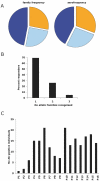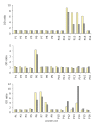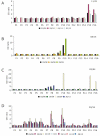Population diversity and antibody selective pressure to Plasmodium falciparum MSP1 block2 locus in an African malaria-endemic setting
- PMID: 19832989
- PMCID: PMC2770483
- DOI: 10.1186/1471-2180-9-219
Population diversity and antibody selective pressure to Plasmodium falciparum MSP1 block2 locus in an African malaria-endemic setting
Abstract
Background: Genetic evidence for diversifying selection identified the Merozoite Surface Protein1 block2 (PfMSP1 block2) as a putative target of protective immunity against Plasmodium falciparum. The locus displays three family types and one recombinant type, each with multiple allelic forms differing by single nucleotide polymorphism as well as sequence, copy number and arrangement variation of three amino acid repeats. The family-specific antibody responses observed in endemic settings support immune selection operating at the family level. However, the factors contributing to the large intra-family allelic diversity remain unclear. To address this question, population allelic polymorphism and sequence variant-specific antibody responses were studied in a single Senegalese rural community where malaria transmission is intense and perennial.
Results: Family distribution showed no significant temporal fluctuation over the 10 y period surveyed. Sequencing of 358 PCR fragments identified 126 distinct alleles, including numerous novel alleles in each family and multiple novel alleles of recombinant types. The parasite population consisted in a large number of low frequency alleles, alongside one high-frequency and three intermediate frequency alleles. Population diversity tests supported positive selection at the family level, but showed no significant departure from neutrality when considering intra-family allelic sequence diversity and all families combined. Seroprevalence, analysed using biotinylated peptides displaying numerous sequence variants, was moderate and increased with age. Reactivity profiles were individual-specific, mapped to the family-specific flanking regions and to repeat sequences shared by numerous allelic forms within a family type. Seroreactivity to K1-, Mad20- and R033 families correlated with the relative family genotype distribution within the village. Antibody specificity remained unchanged with cumulated exposure to an increasingly large number of alleles.
Conclusion: The Pfmsp1 block2 locus presents a very large population sequence diversity. The lack of stable acquisition of novel antibody specificities despite exposure to novel allelic forms is reminiscent of clonal imprinting. The locus appears under antibody-mediated diversifying selection in a variable environment that maintains a balance between the various family types without selecting for sequence variant allelic forms. There is no evidence of positive selection for intra-family sequence diversity, consistent with the observed characteristics of the antibody response.
Figures










Similar articles
-
Genetic diversity and allele frequencies of Plasmodium falciparum msp1 and msp2 in parasite isolates from Bioko Island, Equatorial Guinea.Malar J. 2018 Dec 7;17(1):458. doi: 10.1186/s12936-018-2611-z. Malar J. 2018. PMID: 30526609 Free PMC article.
-
Plasmodium falciparum merozoite surface protein 1 (MSP1): genotyping and humoral responses to allele-specific variants.Acta Trop. 2002 Jan;81(1):33-46. doi: 10.1016/s0001-706x(01)00188-7. Acta Trop. 2002. PMID: 11755430
-
Genetic diversity of Plasmodium falciparum in Bolifamba, on the slopes of Mount Cameroon: influence of MSP1 allelic variants on symptomatic malaria and anaemia.Ann Trop Med Parasitol. 2010 Jan;104(1):25-33. doi: 10.1179/136485910X12607012373876. Ann Trop Med Parasitol. 2010. PMID: 20149290
-
Human IgG subclass antibodies to the 19 kilodalton carboxy terminal fragment of Plasmodium falciparum merozoite surface protein 1 (MSP1(19)) and predominance of the MAD20 allelic type of MSP1 in Uganda.East Afr Med J. 2000 Apr;77(4):189-93. doi: 10.4314/eamj.v77i4.46620. East Afr Med J. 2000. PMID: 12858901
-
Resistance to malaria in humans: the impact of strong, recent selection.Malar J. 2012 Oct 22;11:349. doi: 10.1186/1475-2875-11-349. Malar J. 2012. PMID: 23088866 Free PMC article. Review.
Cited by
-
Genetic diversity of Plasmodium falciparum and genetic profile in children affected by uncomplicated malaria in Cameroon.Malar J. 2020 Mar 18;19(1):115. doi: 10.1186/s12936-020-03161-4. Malar J. 2020. PMID: 32188442 Free PMC article. Clinical Trial.
-
Plasmodium falciparum populations from northeastern Myanmar display high levels of genetic diversity at multiple antigenic loci.Acta Trop. 2013 Jan;125(1):53-9. doi: 10.1016/j.actatropica.2012.09.008. Epub 2012 Sep 20. Acta Trop. 2013. PMID: 23000544 Free PMC article.
-
Genetic diversity and complexity of Plasmodium falciparum infections in Lagos, Nigeria.Asian Pac J Trop Biomed. 2014 May;4(Suppl 1):S87-91. doi: 10.12980/APJTB.4.2014C1301. Asian Pac J Trop Biomed. 2014. PMID: 25183154 Free PMC article.
-
A polyvalent hybrid protein elicits antibodies against the diverse allelic types of block 2 in Plasmodium falciparum merozoite surface protein 1.Vaccine. 2011 Oct 13;29(44):7811-7. doi: 10.1016/j.vaccine.2011.07.106. Epub 2011 Aug 4. Vaccine. 2011. PMID: 21820475 Free PMC article.
-
Plasmodium relictum MSP-1 capture antigen-based ELISA for detection of avian malaria antibodies in African penguins (Spheniscus demersus).Int J Parasitol Parasites Wildl. 2022 Aug 29;19:89-95. doi: 10.1016/j.ijppaw.2022.08.009. eCollection 2022 Dec. Int J Parasitol Parasites Wildl. 2022. PMID: 36090665 Free PMC article.
References
Publication types
MeSH terms
Substances
LinkOut - more resources
Full Text Sources

